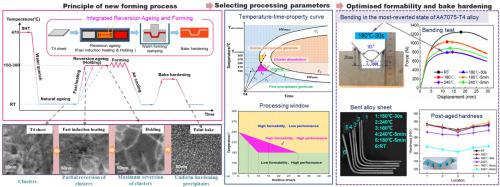International Journal of Machine Tools and Manufacture ( IF 14.0 ) Pub Date : 2023-11-24 , DOI: 10.1016/j.ijmachtools.2023.104091 Chunhui Liu , Jun He , Zhuangzhuang Feng , Peipei Ma , Lihua Zhan

|
Simultaneously improving the formability and post-formed strength of high-strength aluminum (Al) alloys, such as Al–Zn–Mg–Cu alloys, is essential in manufacturing complex-shaped panel components. The strict requirements on heat-treatment condition and high tooling costs limit the applications of current forming methods. A novel process called integrated reversion ageing and forming (IRAF) is proposed to form naturally aged (NA or T4 tempered) Al alloys. A principle-based concept analysis and systematic thermo-mechanical-metallurgical study of the IRAF process were performed. Additionally, tensile tests were conducted to evaluate the effects of parameters including heating rate, holding time, and forming temperature on formability and baked strength. The deformability of the AA7075-T4 alloy can be significantly enhanced through rapid heating to the reversion ageing temperature (150–300 °C), followed by short-term holding, as evidenced by the reduced yield strength of 200 MPa and increased uniform ductility. An instant strength increase to a value close to that of the T6 state was obtained after a short bake hardening (BH) treatment. Further, temperature-time-property (TTP) diagrams were established based on the correlation between the measured mechanical properties and through-process microstructure evolution to explain the mechanism underlying the optimised processing window of IRAF. The results indicate that fast-heating rate (>300 °C/min) promotes the reversion of NA clusters and inhibits re-precipitation of solutes, thereby improving the warm formability. Reversion ageing above 240 °C could induce the formation of coarse η'/η phases, leading to a considerably declined BH response. To accurately predict the strength evolution and deformation behavior during IRAF, a physical-based unified constitutive model was constructed by considering the reversion of NA clusters and solute re-precipitation. The bending and drawing tests on the AA7075-T4 alloy sheets verified that IRAF in the most-reverted state enabled optimum formability. The findings inspire promoting the reversion of pre-existing metastable particles to improve warm formability and post-formed age hardening.
中文翻译:

高强铝合金回复时效与成形一体化:原理与理论基础
同时提高高强度铝合金(例如 Al-Zn-Mg-Cu 合金)的成型性和成型后强度对于制造复杂形状的面板部件至关重要。对热处理条件的严格要求和较高的模具成本限制了现有成形方法的应用。提出了一种称为集成回复时效和成形 (IRAF) 的新工艺来形成自然时效(NA 或 T4 回火)铝合金。对 IRAF 工艺进行了基于原理的概念分析和系统的热机械冶金研究。此外,还进行了拉伸试验,以评估加热速率、保温时间和成型温度等参数对成型性和烘烤强度的影响。通过快速加热至回复时效温度(150-300°C),然后进行短期保温,可以显着增强 AA7075-T4 合金的变形能力,屈服强度降低 200 MPa,均匀延展性提高就证明了这一点。经过短暂烘烤硬化(BH)处理后,强度瞬间增加到接近 T6 状态的值。此外,根据测量的机械性能和整个过程的微观结构演变之间的相关性建立了温度-时间-性能(TTP)图,以解释 IRAF 优化加工窗口的机制。结果表明,快速加热速率(>300℃/min)促进NA团簇的回复并抑制溶质的再沉淀,从而提高温成形性。超过 240 °C 的回复时效可能会导致粗大 η'/η 相的形成,从而导致 BH 响应显着下降。为了准确预测 IRAF 过程中的强度演化和变形行为,通过考虑 NA 团簇的反转和溶质再沉淀,构建了基于物理的统一本构模型。对 AA7075-T4 合金板材进行的弯曲和拉伸测试证实,IRAF 在最回复状态下能够实现最佳的成形性。这些发现有助于促进预先存在的亚稳态颗粒的回复,以改善热成型性和成型后时效硬化。












































 京公网安备 11010802027423号
京公网安备 11010802027423号